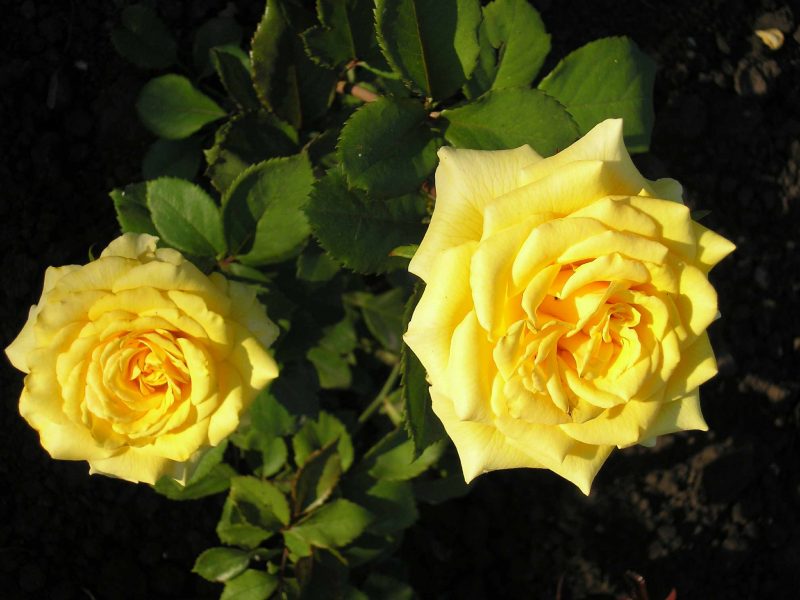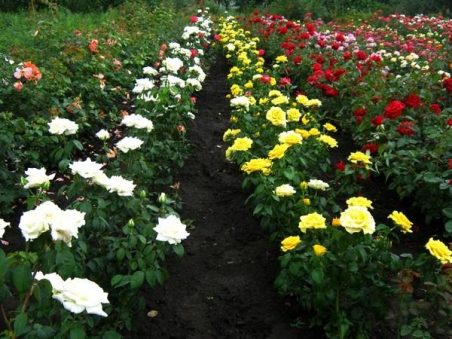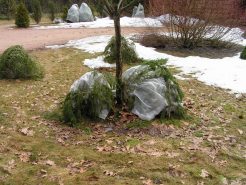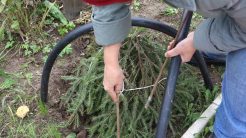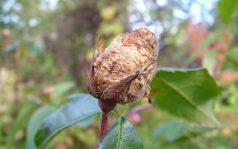Hybrid tea roses are widely spread for a reason: they are characterized by long flowering, high quality inflorescences and varied colors. One of the representatives of the group is the rose "Kerio", among the distinguishing features of which the yellow color of terry flowers stands out.
Material Content:
Description of the variety "Kerio"
Varietal rose was the result of the work of the world famous Dutch company Lex +, which has won such wide recognition due to the development of many high-quality varieties. Rosa "Kerio" is represented by medium-tall bushes up to 1.2 m high, consisting of upright shoots covered with glossy green leafy plates with a characteristic burgundy tint and a small number of spikes. During the flowering period, powerful shoots are crowned with large terry inflorescences of bright yellow color with orange bordering. The diameter of dense flowers can vary from 13 to 15 cm. Due to the slow blooming, the buds keep their shape perfectly. The aroma is hardly perceptible.
The main advantages of the variety:
- aversion to petals burnout;
- tolerance to rainy weather and fungal diseases;
- the acquisition of pink shades of petals in cloudy weather;
- preservation of freshness in cut for 10 days;
- frost resistance.
On a note! When fully opened, the core of the bud remains barely noticeable.
Planting roses in the open ground
In order for the yellow flower to become a permanent inhabitant of the garden and to please its flowering for a long time, you should responsibly approach the issue of planting. For the Kerio rose, a sunny, sheltered from the wind plot with fertile, well-drained soil with a loose structure is selected. The hydrogen indicator of the soil should be at the level of 5.5-7.0 pH (slightly acidic soil).
Step-by-step instructions for carrying out planting operations:
- A seedling purchased at a specialized point of sale is placed in water for 6 hours.
- Planting pits with a depth of 50 cm are being prepared at the site (the parameter may slightly vary in accordance with the root system of the seedling).
- A drainage layer of gravel or broken brick is placed at the bottom, which will protect the root system from moisture stagnation.
- A fertile substrate is prepared from the upper fertile layer with the addition of peat, manure and sand.
- The roots of the seedling are slightly shortened, after which the latter is installed in the pit, where it is sprinkled with the soil mixture so that the root neck is deepened by a maximum of 3 cm.
- The soil around the plant is compacted, moistened and mulched.
- Shoots are shortened to 3 buds.
The optimum landing time is in mid-spring.
How to care for yellow roses
In order for the tea-hybrid rose to grow healthy and delight the eye for a long time, it is necessary to organize proper care for it.
The flower is watered moderately after the surface layer dries. In the spring, as a rule, the bush has enough natural moisture reserves. But in the summer and early autumn, if the cultivation region is characterized by arid conditions, the rose should be moistened by the intrasoil method three times a week. For irrigation, settled water of room temperature is used. In autumn, the frequency of irrigation is reduced so that the plant is well prepared for winter.
After wetting, it is recommended to loosen the soil in the near-stem circle. But this should be done not deeply, since it is possible to damage the root system located close to the surface. To save time, you can cover the trunk circle with a layer of mulch. When mulching, sawdust, compost or peat are used. The latter also supports the fertility of the soil and slightly acidifies it.
If the soil was enriched during planting, then top dressing should be started only from the second year. In the spring, it is recommended to give preference to manure containing nitrogen in an accessible form, or to use ammonium nitrate. In the future, phosphorus-potassium complexes are introduced under the bush, providing abundant, prolonged flowering and strong immunity of the plant.
Pruning flowers - complete instructions
Kerio roses are pruned in the spring after the awakening of the buds, when it becomes clear which shoots have suffered.
At that time:
- All frozen and damaged shoots are cut to healthy wood.
- Branches growing inward are removed.
- All others are shortened to a height of 15 cm.
In the fall, the procedure is repeated with the only difference that the height of healthy shoots should be 20 cm. Throughout the entire flowering period, the bush is also pruned to remove faded inflorescences.
Shelter of roses "Kerio" for the winter
Despite the fact that the variety is cold-resistant, with the onset of frost, the plant should be rolled up. When a stable frosty temperature is established, in regions with a more severe climate, it is recommended to cover the plantings with spruce branches or to build a frame covered with roofing material.
Pest and Disease Control
In conditions of excessive watering and rainy weather on the shoots, foci of development of such fungal diseases as powdery mildew, rust, spotting or gray rot can be observed. Effective remedies are considered chemical preparations fungicides, which must contain copper for the treatment of such ailments. Among the pests, the aphid is the most dangerous, which not only sucks the juice from the leaves, but also is a carrier of viral diseases. At the first signs of the activity of a harmful insect, the bushes should be treated with an insecticide.
Important! Pesticide treatments should be carried out in dry, calm weather in the morning or evening, when solar activity is minimal.
Thanks to how the plant looks, the Kerio variety has won the love of many gardeners.Bright yellow flowers can be found not only adorning private front gardens, but also cultivated on an industrial scale for cutting and future implementation.
Read also:how to grow a rose


